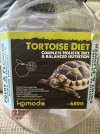My Russian Tortoise has been tube fed for the last 7 weeks, however in that time his weight has fluctuated quite a bit and he is only 10g heavier than the first week (currently 654g). I’m confused because we’ve been feeding him twice a day via the tube and he has also been eating on his own.
We are back at the vets tomorrow and I expect he’ll undergo more tests, but any advise would be appreciated so I have a bit more of an understanding.
We are back at the vets tomorrow and I expect he’ll undergo more tests, but any advise would be appreciated so I have a bit more of an understanding.

